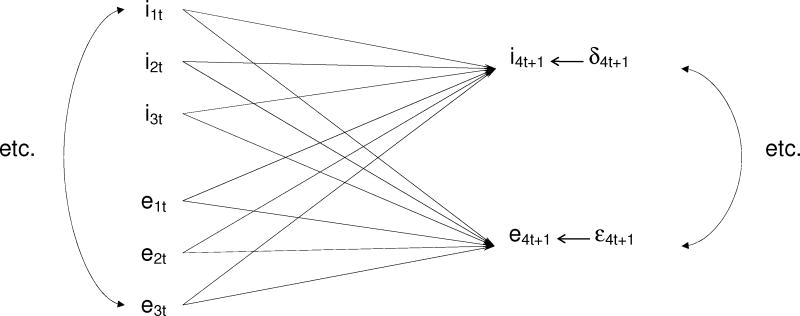Figure 1.
Figure 1a. Schematic of the multivariate observed variable model1
1Only three observed lifetime time t internalizing disorders (e.g., i1t represents internalizing disorder 1 at time t) and externalizing disorders along with only one observed internalizing and one observed externalizing disorder at time t+1 are shown to simplify the presentation, but there were 10 observed lifetime internalizing and 8 observed externalizing disorders in the actual survival model at each time point. First onset of each of these 18 disorders between times t and t+1 was predicted by prior lifetime history of the other 17 disorders as of time t. Estimation was made in 18 separate survival equations, each with 17 predictors for prior history of the other disorders, for a total of 306 (18×17) pair-wise time-lagged associations between earlier and later mental disorders. The 17 predictor disorders were treated as time-varying covariates in a discrete-time (person-year) survival framework. Controls were also included for respondent age at interview, sex, person-year, and country.
Figure 1b. Schematic of the multivariate latent variable model1
1Only three observed lifetime time t internalizing disorders (e.g., i1t represents internalizing disorder 1 at time t) and externalizing disorders and only three disorders of each set at time t+1 are shown to simplify the presentation, but there were 10 observed lifetime internalizing and 8 observed externalizing disorders in the actual survival model. First onset of each of these 18 disorders between times t and t+1 was predicted by latent internalizing or latent externalizing variables at time t+1. These latent variables, in turn, were predicted by lifetime history of latent internalizing and externalizing variables as of time t. These time t latent variables, finally, were predicted by lifetime history of observed internalizing or externalizing variables as of time t. Estimation was carried out using a three-part iterative procedure. See the text for more details. A total of 36 independent associations were estimated, 270 fewer than in the model for associations among observed disorders. As in the earlier observed variable model, the predictor disorders were treated as time-varying covariates in a discrete-time (person-year) survival framework and controls were included for respondent age at interview, sex, person-year, and country.


